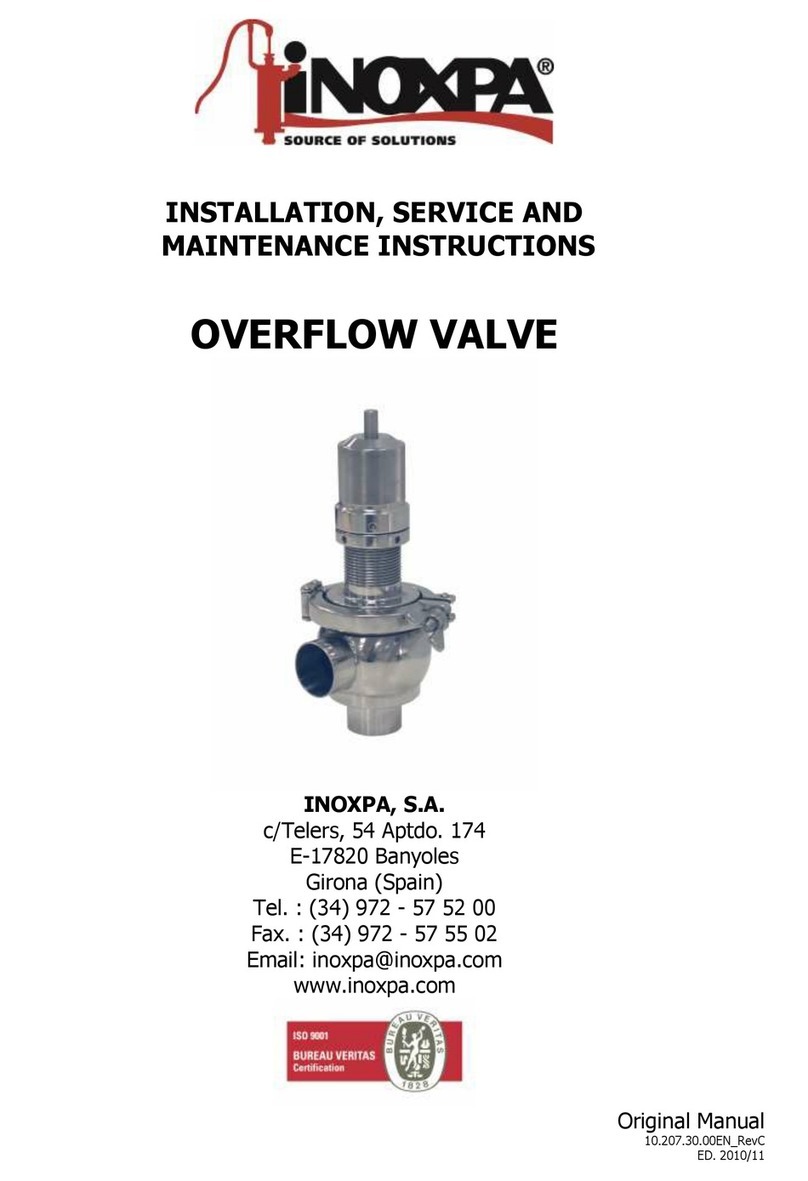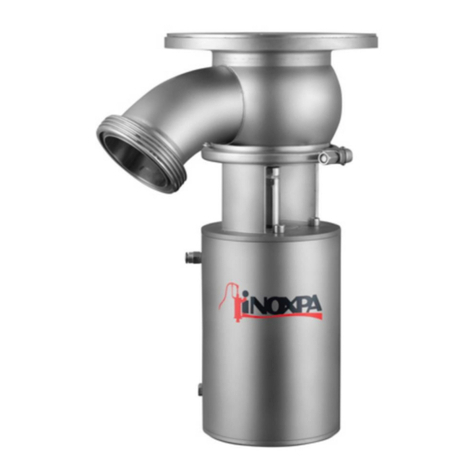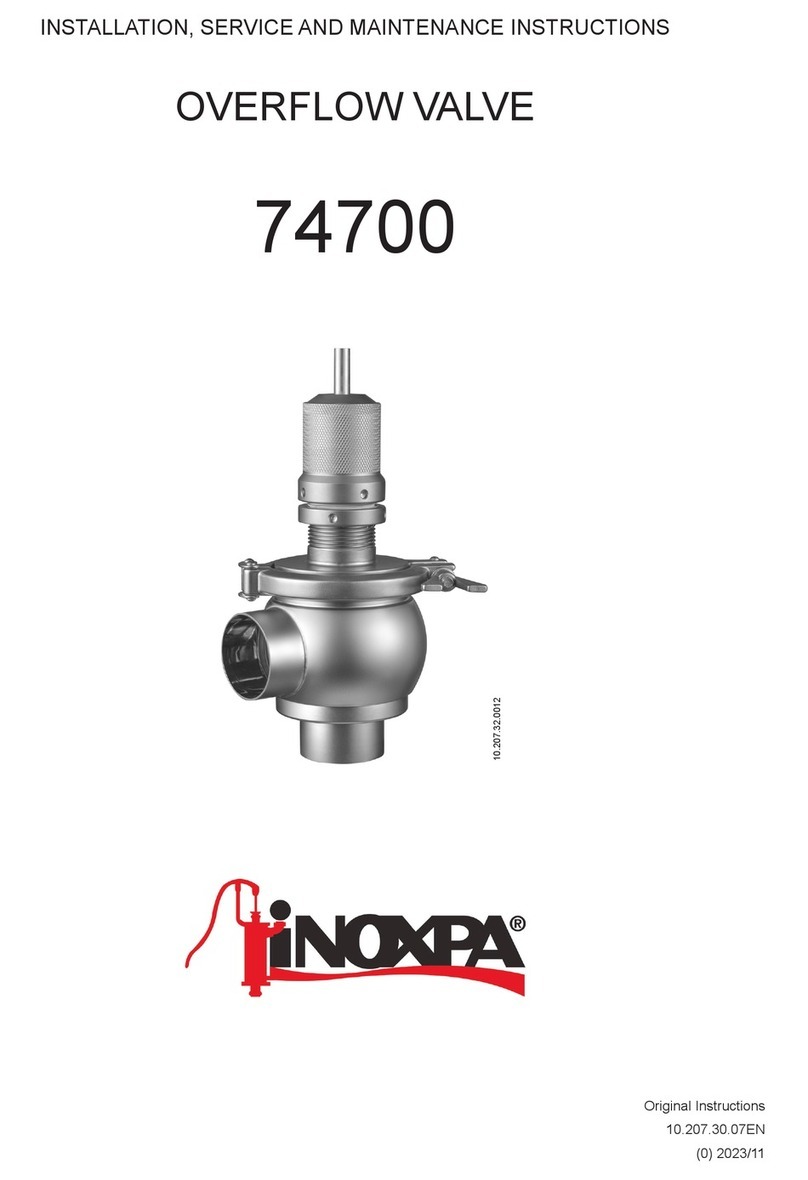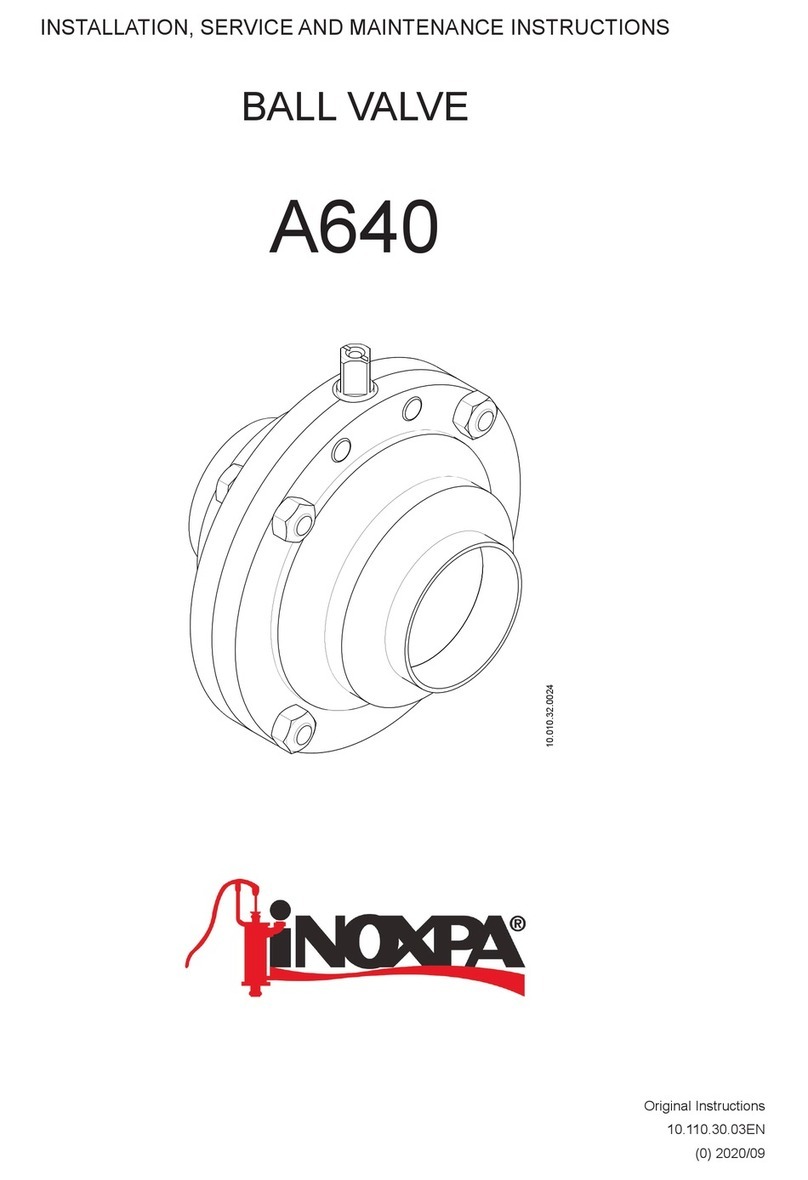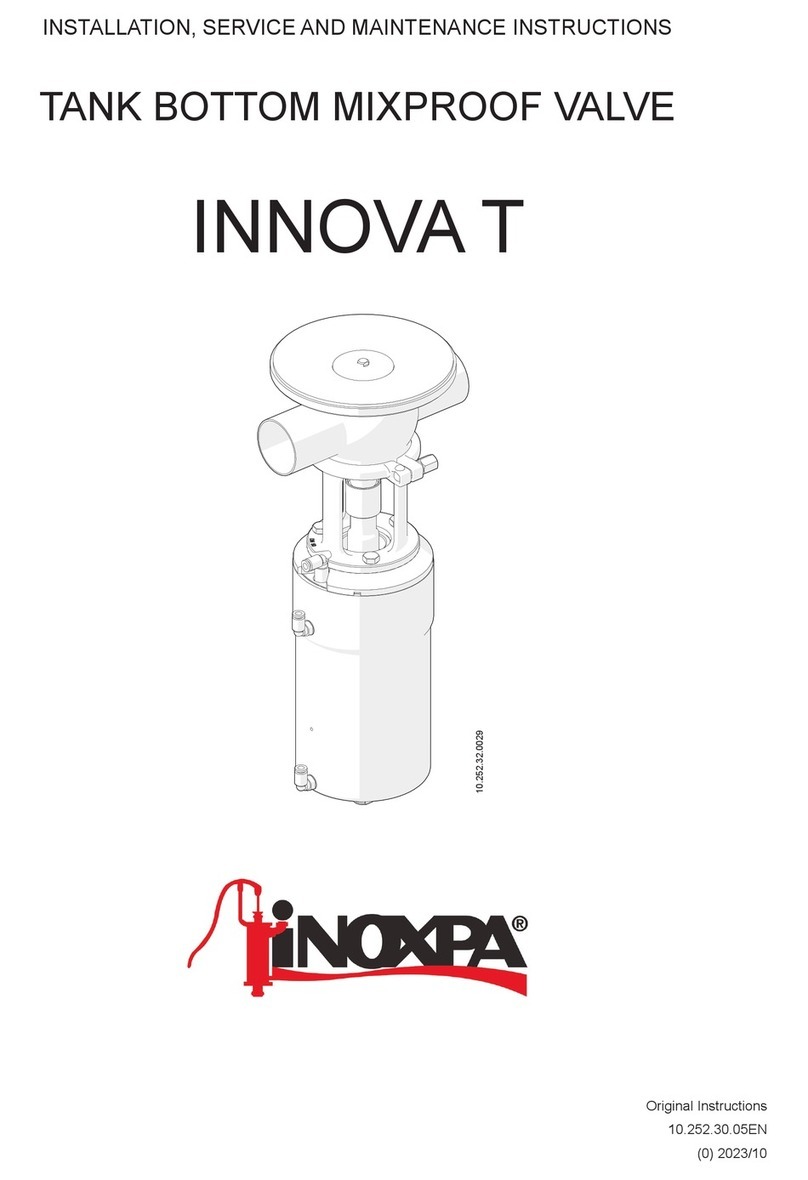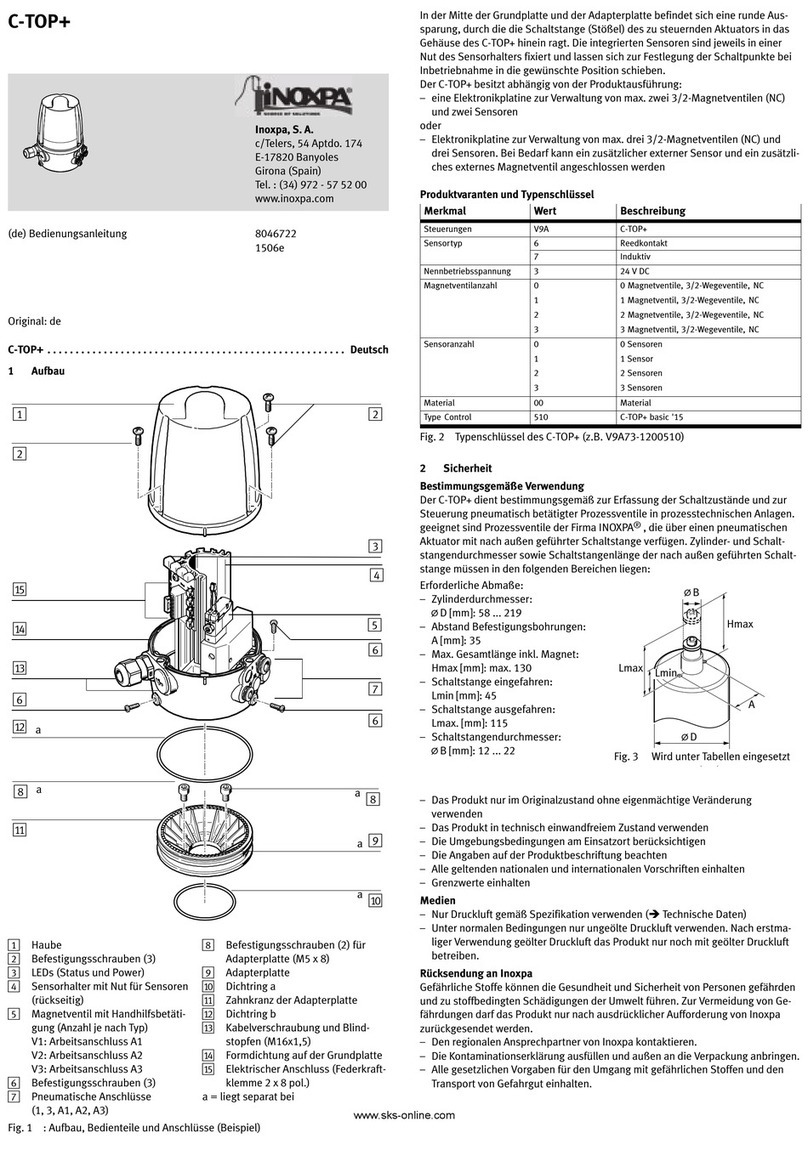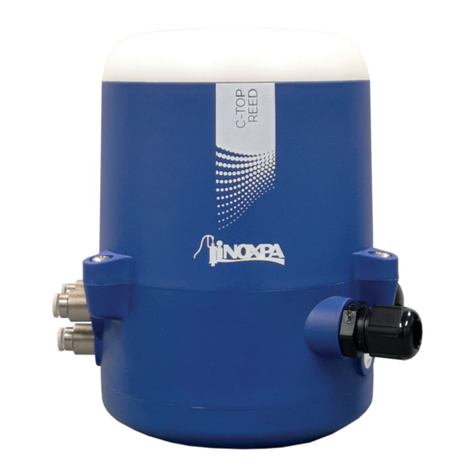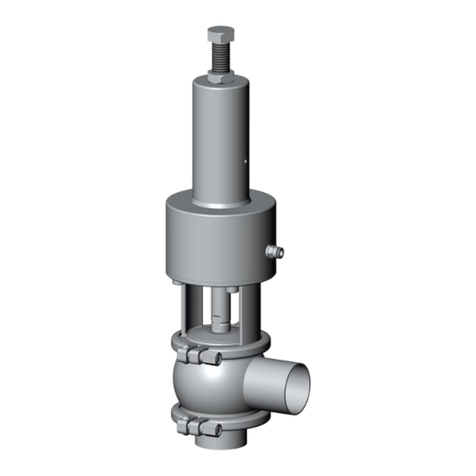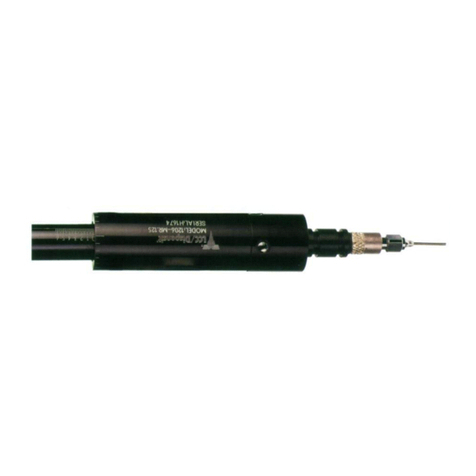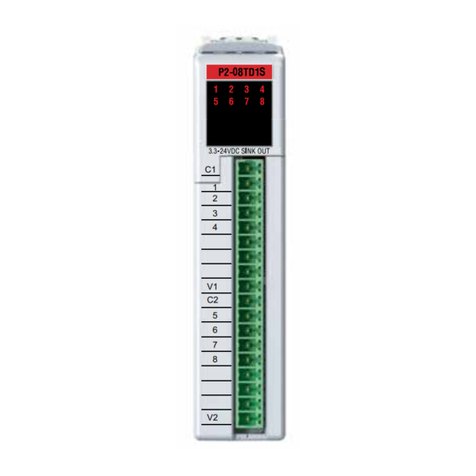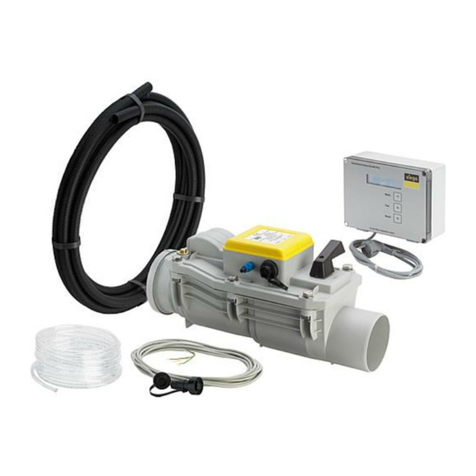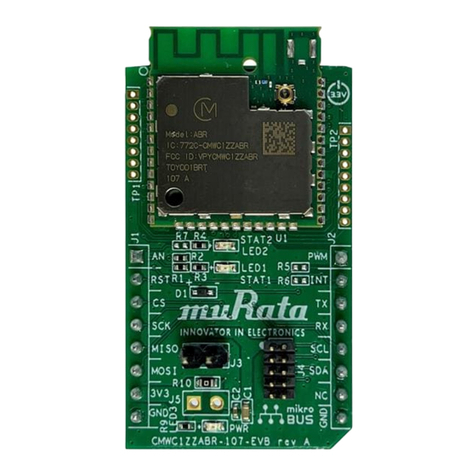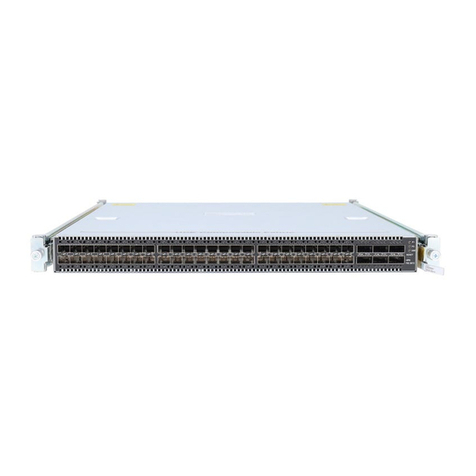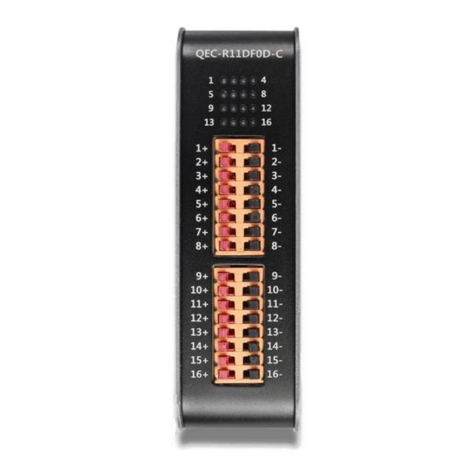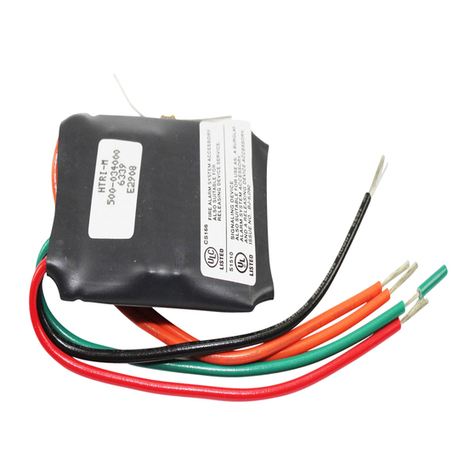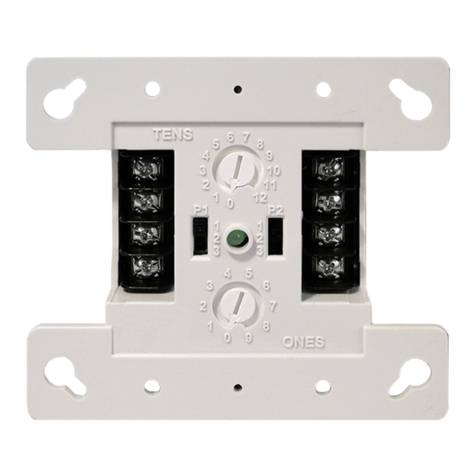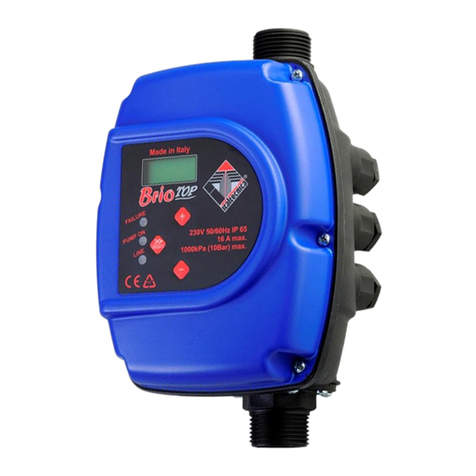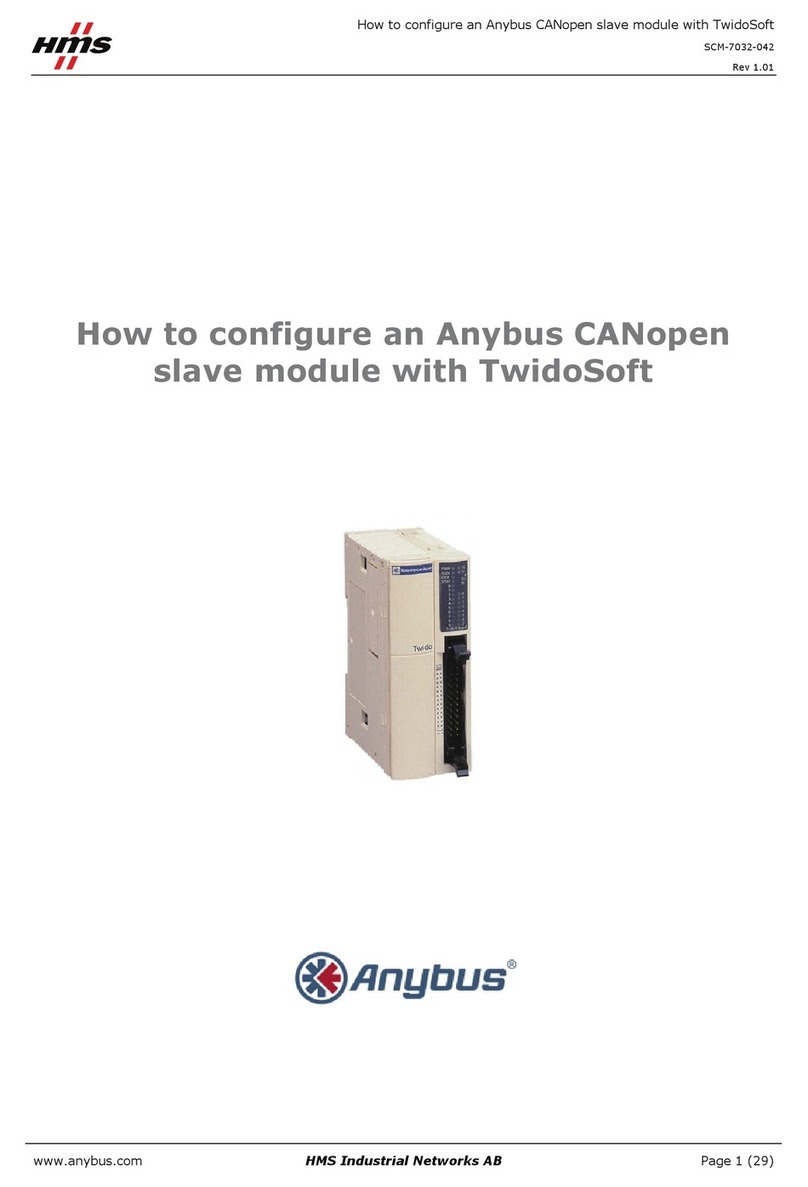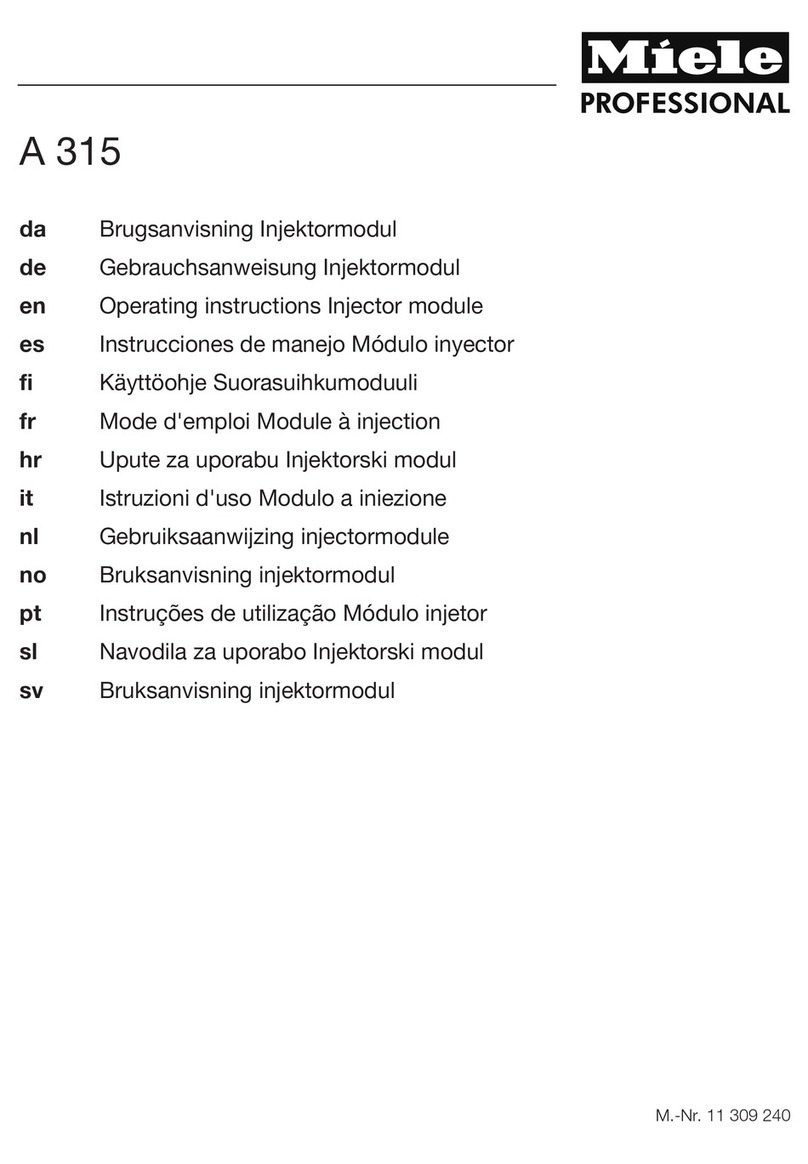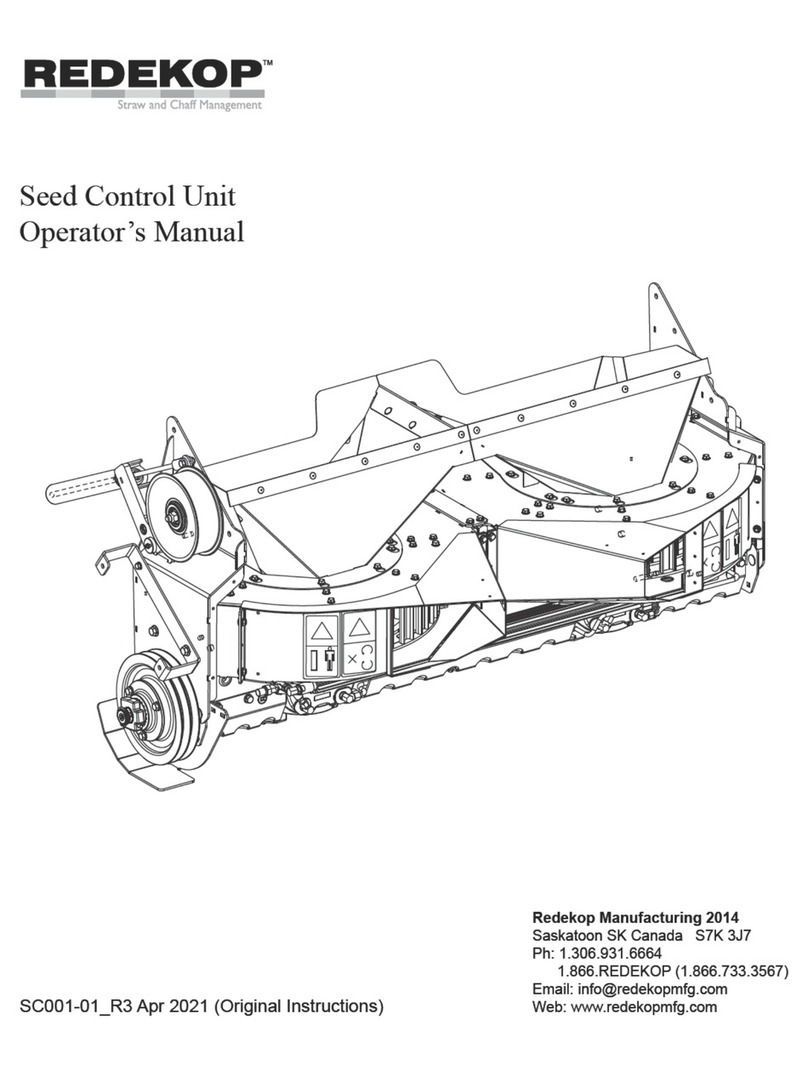INOXPA 72700 Manual

INSTALLATION, SERVICE AND
MAINTENANCE INSTRUCTIONS
CHECK VALVE
INOXPA, S.A.
c/Telers, 54 Aptdo. 174
E-17820 Banyoles
Girona (Spain)
Tel. : (34) 972 - 57 52 00
Fax. : (34) 972 - 57 55 02
Email: inoxpa@inoxpa.com
www.inoxpa.com
Original Manual
10.501.30.00EN_RevB
ED. 2010/11

Declaration of Incorporation
The manufacturer: INOXPA, S.A.
c/ Telers, 57
17820 Banyoles (Girona), Spain
herewith declares that the machine:
CHECK valve 72700
with the serial number: ________________
conforms to the relevant provisions of the following directives:
Machinery Directive 2006/42/EC (RD 1644/2008)
Pressure equipment Directive 97/23/EC
It also declares that the technical documentation for this partly completed machinery has been developed in
compliance with Appendix VII Section B and it agrees to issue this documentation as and when required by the
national authorities.
In compliance with Regulation (EC) 1935/2004 on materials and articles intended to come into contact with food.
In compliance with Regulation (EC) 2023/2006 on good manufacturing practice for materials and articles intended
to come into contact with food.
The aforementioned partly completed machinery shall NOT be put into service until the final machinery into which
it is to be incorporated has been declared in conformity with the Machinery Directive, as required by Appendix II A.
Identification of the person empowered to draw up the Declaration on behalf of the manufacturer, and qualified to
compile the technical file established by the Community:
Banyoles, 8 January 2014
David Reyero Brunet
Technical Office Manager

ED. 2010/11 1.Safety 3
1.Safety
1.1. INSTRUCTION MANUAL
This instruction manual contains basic indications which should be fulfilled during the installation, starting and maintenance.
The information published in the instruction manual is based on updated information.
INOXPA reserves the right to modify this instruction manual without prior notice.
1.2. START-UP INSTRUCTIONS
This instruction manual contains essential useful information to handle and maintain your valve appropriately .
Not only should the safety instructions indicated in this chapter be observed and fulfilled, but so should the special measures
and recommendations included in the other chapters of this manual. These instructions should be kept in a safe location near
the installation.
1.3. SAFETY
1.3.1. Warning symbols.
General danger of injury
Danger of injuries caused by the rotary
parts of the equipment
Electrical hazard
Danger! Caustic or corrosive agents.
Danger! Suspended loads
Danger for the correct operation of the
equipment.
Compulsory requirement to ensure safety
at work
Use of goggles is compulsory.
1.4. GENERAL SAFETY INSTRUCTIONS
Read the instruction manual carefully before installing and starting up the valve. Contact INOXPA in
case of doubt
1.4.1. During the installation.
The
Technical Specifications
of Chapter 8 should always be observed.
The installation and use of the valve should always be carried out in accordance with applicable
regulations regarding health and safety.
Before starting up the valve, verify that the assembly is correct and that the shaft is perfectly
aligned. An incorrect alignment and/or excessive force in securing the valve may cause serious
mechanical problems in the valve.
1.4.2. During operation.
The
Technical Specifications
of Chapter 8 should always be observed. Under no circumstances can the
limit values specified be exceeded.
NEVER touch the valve and/or the tubes in contact with the liquid during operation. You risk being
burnt if you work with hot products.

4 1.Safety ED. 2010/11
The valve contains parts operating in linear movement. Do not place your hands or fingers in the
valve-closing area. This may cause serious injury.
1.4.3. During maintenance
The
Technical Specifications
of Chapter 8 should always be observed.
NEVER disassemble the valve until the pipes have been emptied. Bear in mind that the liquid in the
pipe may be dangerous or extremely hot. Consult the regulations in effect in each country for these
cases.
Do not leave parts loose on the floor.
All electrical work should be carried out by authorised personnel.
1.4.4. In compliance with the instructions.
Any non-fulfilment of the instructions may result in a risk for the operators, the environment and the machine, and may result
in the loss of your right to claim damages
This non-fulfilment may result in the following risks:
Failure of important functions of the machines/plant.
Failure of specific maintenance and repair procedures.
Possibility of electric, mechanical and chemical risks.
Will place the environment in danger due to the release of substances.
1.5. GUARANTEE.
Any guarantee will be cancelled immediately and as a matter of law and, in addition, we will require compensation for any
claims of civil liability presented by third parties, if:
The installation and maintenance work has not been carried out according to the instructions of this manual.
The repairs are not carried out by our personnel or have been carried out without our written authorisation.
The parts used are not INOXPA original parts.
Modifications have been carried out on our materials without written authorisation.
The material has been badly used, incorrectly used, or used with negligence or has not been used according to the
indications and intended use specified in this manual.
The general conditions of delivery already in your possession are also applicable.
Please do not hesitate to contact us in case of doubts or more complete explanations are required on specific data
(adjustments, assembly, disassembly, etc.).

ED. 2010/11 2.Table of contents 5
2.Table of contents
1. Safety 3
1.1. Instruction Manual .........................................................................................................3
1.2. Start-Up instructions ......................................................................................................3
1.3. Safety...........................................................................................................................3
1.4. General safety instructions..............................................................................................3
1.5. Guarantee.....................................................................................................................4
2. Table of contents 5
3. Receiving and Installation 6
3.1. Check the Shipment .......................................................................................................6
3.2. Delivery and unpacking ..................................................................................................6
3.3. Identification .................................................................................................................6
3.4. Location........................................................................................................................7
3.5. Assembly ......................................................................................................................7
3.6. Inspecting and Checking.................................................................................................7
3.7. Welding ........................................................................................................................7
4. Start-Up 9
4.1. Start-Up........................................................................................................................9
4.2. Operation......................................................................................................................9
5. Operating problems: Causes and solutions 10
6. Maintenance 11
6.1. General Information.....................................................................................................11
6.2. Maintenance................................................................................................................11
6.3. Cleaning......................................................................................................................12
7. Assembly and disassembly 13
7.1. Disassembly / Assembly of the Check Valve....................................................................13
7.2. Check Valve Position ....................................................................................................13
8. Technical Specifications 14
8.1. Weld / Weld Check Valve Dimensions ............................................................................15
8.2. Section and Part List ....................................................................................................16
8.3. Spare Parts .................................................................................................................16

6 3.Receiving and Installation ED. 2010/11
3.Receiving and Installation
3.1. CHECK THE SHIPMENT
The first thing to do on receiving the valve is to verify that it is matches the delivery slip.
INOXPA will inspect all the equipment before packing, although it cannot guarantee that the merchandise will arrive intact to
the user. For this reason, the valve received and any other article should be checked and, if it is found not to be in good
condition and/or not all parts are included, the carrier should submit a report as soon as possible.
Each valve has a manufacturing number engraved. Indicate the manufacturing number in all documents and correspondence.
3.2. DELIVERY AND UNPACKING
INOXPA will not be responsible for the inappropriate unpacking of the valve and its components.
3.2.1. Delivery:
Check that all the parts indicated in the delivery slip exist
Complete valve.
Its components (if supplied).
Delivery slip.
Instruction manual.
3.2.2. Unpacking:
Remove all traces of packing materials from the valve or parts.
Inspect the valve or its constituent parts for possible damage caused during transport.
Avoid any possible damage to the valve and its components.
3.3. IDENTIFICATION

ED. 2010/11 3.Receiving and Installation 7
The buyer or user will be responsible for the assembly, installation, starting and operation of the
valve.
3.4. LOCATION
Place the valve in such a way as to facilitate inspections and checks. Leave sufficient space around the valve for appropriate
inspection, separation and maintenance (See Section 3.7.3).
3.5. ASSEMBLY
Once the location of the valve is established, the pipe can be connected by welding the valve body and cover or by means of
accessories (connectors). The check valve must be installed vertically and in the direction of the flow.
Excessive stress should be avoided during the assembly of
the valves and special attention should be given to the
following:
Vibration which may be produced in the installation.
Expansion of the pipes during circulation of hot liquids.
The weight that the pipes can withstand.
Excessive intensity of welding.
3.6. INSPECTING AND CHECKING
Check the following before use:
Open and close the valve several times to
ensure that it operates correctly and check that
the shaft seal fits smoothly with the valve body.
3.7. WELDING
The welding work can only be carried out by persons qualified, trained and equipped with the
necessary means to carry out this work.
Disassemble the valve before starting the welding work.
Seal bed
S
e
a
l
b
e
d
F
l
u
i
d

8 3.Receiving and Installation ED. 2010/11
3.7.1. Weld/weld check valve. Fig. 72700.
Disassemble the valve as indicated in the
Disassembly
section.
Weld the valve body and cover to the tubes.
On welding the valve body and cover, check that they can be axially separated (See elevation A) in order to disassemble the
internal parts of the valve (gasketl, shaft, guide bush, spring).
If the valve is connected using accessories (connectors), then elevation A may be much lower.
DN
A
25-1”
38
32
39
40-1 ½”
45
50-2”
50
2 ½”
58
65
63
3”
63
80
69
100-4”
78
DN
A
25-1”
2
32
3
40-1 ½”
3
50-2”
5
2 ½”
5
65
5
3”
5
80
5
100-4”
10

ED. 2010/11 4.Start-Up 9
4.Start-Up
The start-up of the valve can be carried out if the instructions indicated in Chapter 3 –
Receiving and Installation
are followed.
4.1. START-UP
Before start-up, the responsible persons should be duly informed of the operation of the valve and
the safety instructions to be followed. This instruction manual should be available to personnel at all
times.
The following should be taken into consideration before starting-up the valve:
Check that the pipe and valve are completely free from any traces of welding or other foreign matter. Carry out the cleaning of
the system if required.
Verify the smooth operation of the valve. If necessary, lubricate with special grease or soapy water.
Check for possible leaks and check that all the pipes and connections are watertight and free from leaks.
Operate the valve.
4.2. OPERATION
Do not modify the operating parameters for which the valve has been designed without written prior
authorisation from INOXPA.
Danger of burns! Do not touch the valve or pipes when hot liquids are circulating or when cleaning
and/or sterilisation are being carried out.
This equipment is suitable for to use in food processes.

10 5.Operating problems: Causes and solutions ED. 2010/11
5.Operating problems: Causes and
solutions
* It is possible for leaks to occur in the stainless-steel/stainless-steel seatings leading to insufficient liquid in the downstream
tubes.
PROBLEM
CAUSE/EFFECT
SOLUTION
EXTERNAL LEAK.
THE PRODUCT IS
LEAKING FROM THE
CLAMP
The joining seal is worn out or deteriorated.
Loss of water-tightness
Replace the seals.
Replace the seals with others of
different material and more
appropriate for the product.
Tighten the clamp
INTERNAL LEAK OF
THE PRODUCT
(VALVE CLOSED)
Premature wearing of the seals
Replace the seals.
Premature
wearing of
the seals
Watertight seal worn or affected by the
product.
Excessive pressure in the line.
Working temperature too high
Loss of watertightness (vibration).
Replace the seals with others of
different quality, if prematurely
deteriorated.
Tighten the weak pieces
Clean frequently
Backpressure
Replace the spring with a stronger
one.
VALVE DOES NOT
OPEN/CLOSE
Deformation of sealing joint.
Spring in poor condition and/or jammed (dirtiness)
Replace the seals with others of
different quality, if prematurely
deteriorated.
Replace spring and/or shaft (clean).

ED. 2010/11 6.Maintenance 11
6.Maintenance
6.1. GENERAL INFORMATION
This valve, just like any other machine, requires maintenance. The instructions contained in this manual cover the identification
and replacement of spare parts. The instructions have been prepared for maintenance personnel and for those responsible for
the supply of spare parts.
Carefully read Chapter 8.
Technical Specifications
.
All replaced material should be duly eliminated/recycled according to the directives in effect in the
area.
Assembly and disassembly of the valves must only be carried out by qualified staff.
Before starting on maintenance work, ensure that the tubes are not pressurised.
6.2. MAINTENANCE
The following is recommended for appropriate maintenance:
Regular inspection of the valve and its components.
Keep a record of the operation of each valve, noting any incidents.
Always have spare seals in stock.
During maintenance, pay particular attention to the danger indications indicated in this manual.
The valve and pipes should not be pressurised during maintenance.
The valve should not be hot during maintenance. Danger of burns!
6.2.1. Maintenace
REPLACEMENT OF SEALS
Preventive maintenance
Replace after twelve (12) months.
Maintenance after a leak
Replace at the end of the process.
Scheduled maintenance
Regularly check that there are no leaks and that the valve is operating smoothly.
Keep a record of the valve.
Use statistics to plan inspections.
Lubrication
During assembly, apply lubricants compatible with the seal material. See the
following table.
SEAL COMPONENT
LUBRICANT
Class NLGI DIN
51818
NBR/ FPM/ VMQ
Klübersynth UH 1 64-2403
3
EPDM/ NBR/ FPM
PARALIQ GTE 703
3
The time interval between each preventive maintenance may vary according to the working conditions to which the valve is
submitted: Temperature, pressure, number of operations per day, type of cleaning solutions used, etc.
6.2.2. Storage
Storage of the valves should be carried out in an enclosed area, under the following conditions:
Temperature from 15ºC to 30ºC
Relative humidity <60%
Open-air storage of the equipment is NOT allowed.

12 6.Maintenance ED. 2010/11
6.2.3. Spare parts
To request spare parts, it is necessary to indicate the type of valve, the position and the description of the part which can be
found in the Technical Specifications chapter.
6.3. CLEANING
The use of aggressive cleaning products such as caustic soda and nitric acid may cause burns to the
skin.
Use rubber gloves during the cleaning process.
Always use protective goggles.
6.3.1. Automatic CIP (cleaning-in-place)
If the valve is installed in a system provided with the CIP process, its disassembly will not be required.
Cleaning solutions for CIP processes.
Only use clear water (chlorine-free) to mix with the cleaning agents:
a) Alkaline solution: 1% by weight of caustic soda (NaOH) at 70ºC (150ºF)
1 Kg NaOH + 100 l. of water = cleaning solution
o
2.2 l. NaOH at 33% + 100 l. of water = cleaning solution
b) Acid solution: 0.5% by weight of nitric acid (HNO3) at 70ºC (150ºF)
0.7 litres HNO3at 53% + 100 l. of water = cleaning
Check the concentration of cleaning solutions; it may cause the deterioration of the watertight seals
of the valve.
To remove any remains of cleaning products, ALWAYS perform a final rinse with clean water on completion of the cleaning
process.
Before beginning the disassembly and assembly work, clean the valve inside as well as outside.
6.3.2. Automatic SIP (sterilization-in-place)
The process of sterilization with steam is applied to all the equipment including the pigging.
Do NOT start the equipment during the process of sterilization with steam.
The parts/materials suffer no damage if the indications specified in this manual are observed.
No cold liquid can enter the equipment till the temperature of the equipment is lower than 60°C
(140°F).
Maximum conditions during the SIP process with steam or overheated water
a) Max. temperature: 140°C / 284°F
b) Max. time: 30 min
c) Cooling: Sterile air or inert gas
d) Materials: EPDM / PTFE (recommended)
FPM / NBR / VMQ (not recommended)

ED. 2010/11 7.Assembly and disassembly 13
7.Assembly and disassembly
Proceed with caution. There is danger of personal injury.
Assembly and disassembly of the valves must only be carried out by qualified staff.
7.1. DISASSEMBLY / ASSEMBLY OF THE CHECK VALVE
Assembly
1. Loosen the clamp (23) and remove it from the
housing (01) and the cap (22),
2. Separate the cap (22) from the housing (01).
3. Remove the gasket (21) from the body.
4. Remove the guide bush (20), the spring (06), shaft
(08) and the shaft gasket (20A)
5. Separate the guide bush, spring, and shaft.
6. Disassemble the toric gasket (20A) from the shaft
body.
Assembly
1. Place the gasket (20A) in the shaft body (08).
Lubricate the gasket if necessary.
2. Place the spring (06) on the shaft (08), Take the
guide bush (20) and attach it to the shaft / spring.
3. Set the spring, shaft, and bush grouping
(06,08,20) into the valve housing (01),
4. Place the gasket (21) on the valve housing.
5. Place the cap (22) over the gasket (21),
6. Place the clamp (23) so that the flanges of the cap
(22) and the valve housing (01) are inside the
clamp.
7. Tighten the wing nut of the clamp (23).
NO tools are required to disassemble the valve
7.2. CHECK VALVE POSITION
The check valve is designed to be installed in a vertical position, and with the flow direction indicated in this manual.

14 8.Technical Specifications ED. 2010/11
8.Technical Specifications
VALVE GENRAL DATA
Maximum working pressure
DN-25/100
DN-1"/4"
10 bar
Maximum working temperature
121ºC (250ºF) EPDM standard seals
(Other qualities of seals will be adapted for higher temperatures)
Opening pressure
DN-25 - 1”
DN-32/40 –1½”
DN-50/100 –2”/4”
0,3bar
0,2bar
0,1bar
Surface finish
In contact with the product: Ra 0.8 μm
External surfaces: Machined finish (turned on lathe)
VALVE MATERIALS
Parts in contact with the media
AISI 316L (1.4404)
Other steel parts
AISI 304 (1.4301)
Gaskets in contact with the media
EPDM (STANDARD) - NBR - VITON - SILICONA.
Surface finish
Parts in contact with the media Ra. 0.8m
Type of connections
DIN 11851 (Standard)
Welding, FIL-IDF, BS-RJT, SMS, Clamp, Flanges, Macon.

ED. 2010/11 8.Technical Specifications 15
8.1. WELD / WELD CHECK VALVE DIMENSIONS
DN
d1
L
AISI 316L
DN
d1
L
AISI 316L
1”
22,1
73
272700101E
25
26
73
272700025E
1 ½”
34,8
80
272700112E
32
32
73
272700032E
2”
47,5
85
272700200E
40
38
80
272700040E
2 ½”
60,2
110
272700212E
50
50
85
272700050E
3”
72,9
115
272700300E
65
66
110
272700065E
4”
97,6
125
272700400E
80
81
115
272700080E
100
100
125
272700100E
DN
d1
L
AISI 316L
25
26
73
272710025E
32
32
73
272710032E
40
38
80
272710040E
50
50
85
272710050E
65
66
110
272710065E
80
81
115
272710080E
100
100
125
272710100E
DN
d1
L
AISI 316L
1”
22,1
98
272717101E
1 ½”
34,8
105
272717112E
2”
47,5
110
272717200E
2 ½”
60,2
135
272717212E
3”
72,9
140
272717300E
4”
97,6
157
272717400E
S/S Fig.72700
S/S Fig.72700
M/S Fig. 72710
M/S Fig. 72710
CL/CL Fig. 72717
CL/CL Fig. 72717

16 8.Technical Specifications ED. 2010/11
8.2. SECTION AND PART LIST
POSITION
DESIGNATION
MATERIAL
QUANTITY
01
Housing
AISI 316L
1
06
Spring
AISI 301
1
08
Shaft
AISI 316L
1
17
Guide bush
AISI 316L
1
20*
Shaft gasket
EPDM
1
61*
Clamp seal
EPDM
1
12
Cap
AISI 316L
1
34
Clamp
AISI 304
1
8.3. SPARE PARTS
DN
01
06
08
17
20*
61*
12
34
25
451387.6
MU-450489
450486A.6
450836.6
O4020235
1708200
450814.6
1703200
32
451722.6
450486B.6
O4026535
451723.6
40
451388.6
MU-450490
450486C.6
450837.6
O4032935
1708212
450815.6
1703212
50
451389.6
450486D.6
450838.6
O4040653
1708300
450816.6
1703300
65
451390.6
MU-450491
450486E.6
350318.6
O4050153
1708400
450817.6
1703400
80
350590.6
450486F.6
350319.6
O4062853
1708412
450818.6
1703412
100
350591.6
MU-450492
450486G.6
3503201.6
O4091453
1708512
450819.6
1703512
*
Recommended spare parts .

NOTAS

NOTAS

NOTAS

INOXPA, S.A.
DELEGACIÓN NORD-ESTE /
ARAGÓN
c/ Telers, 54 –PO Box 174
BARBERÀ DEL VALLÈS (BCN)
ZARAGOZA
17820 BANYOLES (GIRONA)
Tel: 937 297 280
Tel: 976 591 942
Tel: 34 972575200
Fax: 937 296 220
Fax: 976 591 473
Fax: 34 972575502
e-mail: inoxpa.aragon@inoxpa.com
e-mail: inoxpa@inoxpa.com
www.inoxpa.com
DELEGACIÓN LEVANTE
DELEGACIÓN CENTRO
DELEGACIÓN STA
PATERNA (VALENCIA)
ARGANDA DEL REY (MADRID)
GALDACANO (BILBAO)
Tel: 963 170 101
Tel: 918 716 084
Tel: 944 572 058
Fax: 963 777 539
Fax: 918 703 641
Fax: 944 571 806
e-mail: inoxpa.centro@inoxpa.com
e-mail: sta@inoxpa.com
DELEGACIÓN SUR
LA CISTÉRNIGA (VALLADOLID)
LOGROÑO
JEREZ DE LA FRONTERA (CÁDIZ)
Tel: 983 403 197
Tel: 941 228 622
Tel / Fax: 956 140 193
Fax: 983 402 640
Fax: 941 204 290
e-mail: inoxpa.sur@inoxpa.com
e-mail: sta.valladolid@inoxpa.com
e-mail: sta.rioja@inoxpa.com
INOXPA SOLUTIONS LEVANTE
INOXPA SOLUTIONS FRANCE
PATERNA (VALENCIA)
GLEIZE
CHAMBLY (PARIS)
Tel: 963 170 101
Tel: 33 474627100
Tel: 33 130289100
Fax: 963 777 539
Fax: 33 474627101
Fax: 33 130289101
e-mail: isf@inoxpa.com
e-mail: inoxpa.fr@inoxpa.com
e-mail: isf@inoxpa.com
INOXPA AUSTRALIA PTY (LTD)
ST. SEBASTIEN sur LOIRE
WAMBRECHIES
MORNINGTON (VICTORIA)
Tel/Fax: 33 130289100
Tel: 33 320631000
Tel: 61 3 5976 8881
e-mail: inoxpa.fr@inoxpa.com
Fax: 33 320631001
Fax: 61 3 5976 8882
e-mail: inoxpa.nord.fr@inoxpa.com
e-mail: inoxpa.au@inoxpa.com
INOXPA ALGERIE
INOXPA SOUTH AFRICA (PTY) LTD
INOXPA USA, Inc
ROUIBA
JOHANNESBURG
SANTA ROSA
Tel: 213 21856363 / 21851780
Tel: 27 117 945 223
Tel: 1 7075 853 900
Fax: 213 21854431
Fax: 27 866 807 756
Fax: 1 7075 853 908
e-mail: inoxpalgerie@inoxpa.com
e-mail: inoxpa.us@inoxpa.com
INOXPA UK LTD
S.T.A. PORTUGUESA LDA
INOXPA ITALIA, S.R.L.
SURREY
VALE DE CAMBRA
BALLO DI MIRANO –VENEZIA
Tel: 44 1737 378 060 / 079
Tel: 351 256 472 722
Tel: 39 041 411 236
Fax: 44 1737 766 539
Fax: 351 256 425 697
Fax: 39 041 5128 414
e-mail: inoxpa-uk@inoxpa.com
e-mail: comercial.pt@inoxpa.com
e-mail: inoxpa.it@inoxpa.com
INOXPA SKANDINAVIEN A/S
IMPROVED SOLUTIONS
PORTUGAL LDA
INOXPA INDIA PVT. LTD.
HORSENS (DENMARK)
VALE DE CAMBRA
Maharashtra, INDIA.
Tel: 45 76 286 900
Tel: 351 256 472 140 / 138
Tel: 91 2065 008 458
Fax: 45 76 286 909
Fax: 351 256 472 130
inoxpa.in@inoxpa.com
e-mail: inoxpa.dk@inoxpa.com
e-mail: isp.pt@inoxpa.com
INOXPA SPECIAL PROCESSING
INOXRUS
EQUIPMENT, CO., LTD.
MOSCOW (RUSIA)
SAINT PETERSBURG (RUSIA)
JIAXING (China)
Tel / Fax: 74 956 606 020
Тel: 78 126 221 626 / 927
Tel.: 86 573 83 570 035 / 036
e-mail: moscow@inoxpa.com
Fax: 78 126 221 926
Fax: 86 573 83 570 038
e-mail: spb@inoxpa.com
INOXPA WINE SOLUTIONS
INOXPA UCRANIA
VENDARGUES (FRANCE)
KIEV
Tel: 33 971 515 447
Tel: 38 050 720 8692
Fax: 33 467 568 745
e-mail: kiev@inoxpa.com
e-mail: frigail.fr@inoxpa.com /
npourtaud@inoxpa.com
npourtaud.fr@inoxpa.com
In addition to our branch offices, INOXPA operates with an independent distributor network which encompasses a total of
more than 50 countries throughout the world.
For more information, please, consult our web page: www.inoxpa.com
This information is for guidance only. We reserve the right to modify any material or feature without notice in advance.
Table of contents
Other INOXPA Control Unit manuals

INOXPA
INOXPA INNOVA F Manual
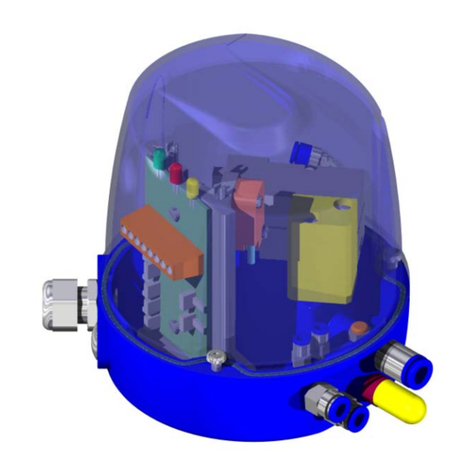
INOXPA
INOXPA C-TOP Installation and user guide
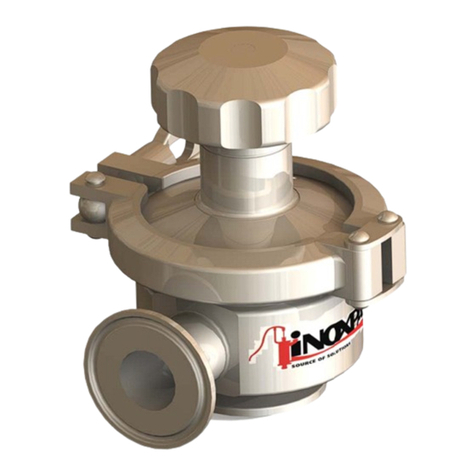
INOXPA
INOXPA PHARMAVALVE Installation and user guide
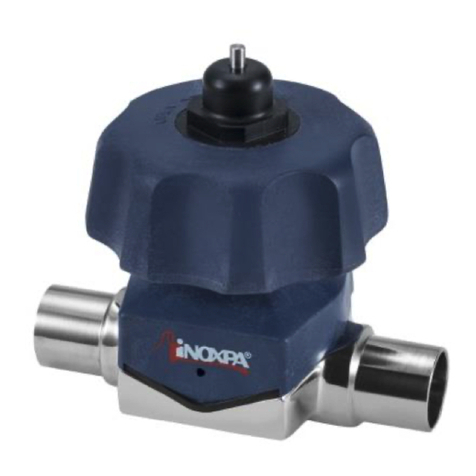
INOXPA
INOXPA VEEVALV Manual
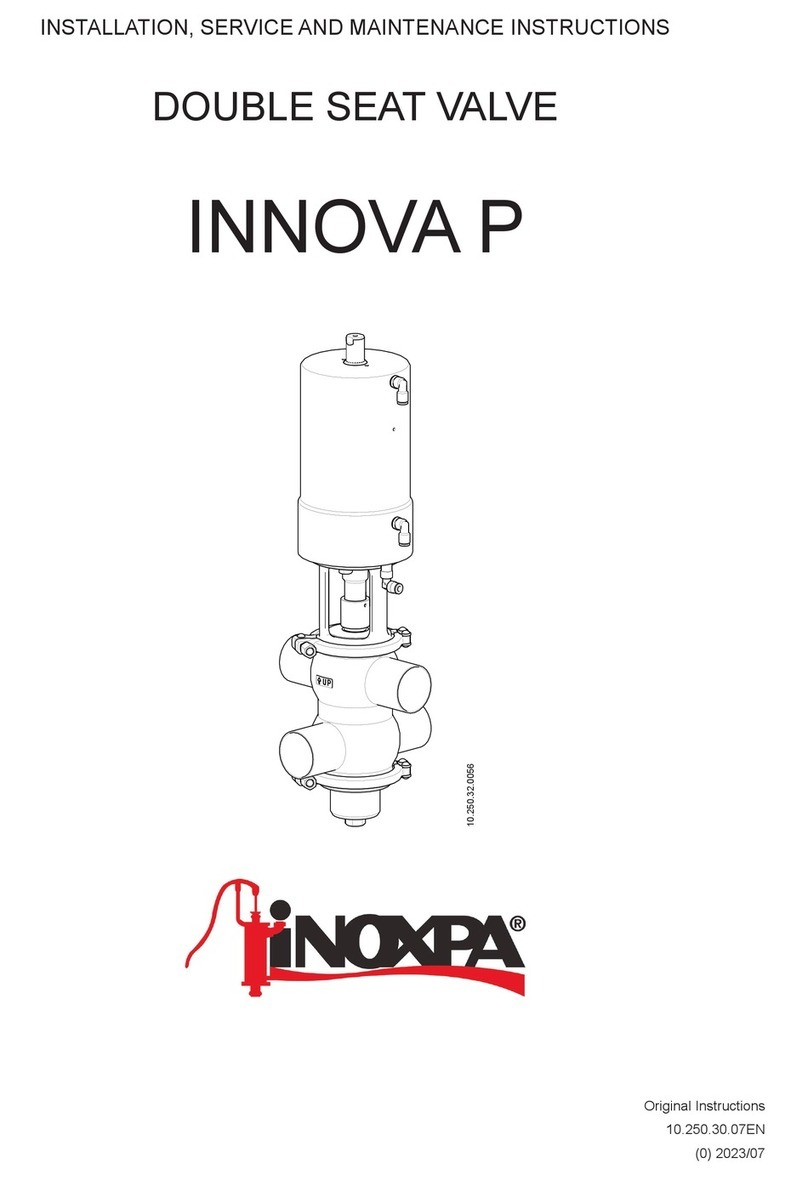
INOXPA
INOXPA INNOVA P Manual
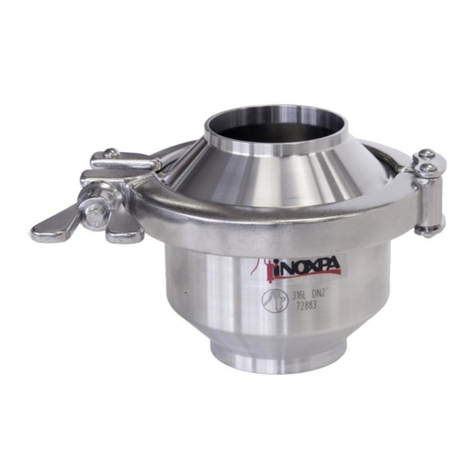
INOXPA
INOXPA Check Manual
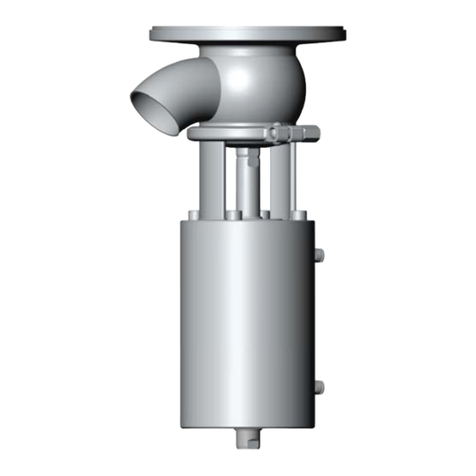
INOXPA
INOXPA INNOVA F Installation and user guide

INOXPA
INOXPA INNOVA S Manual
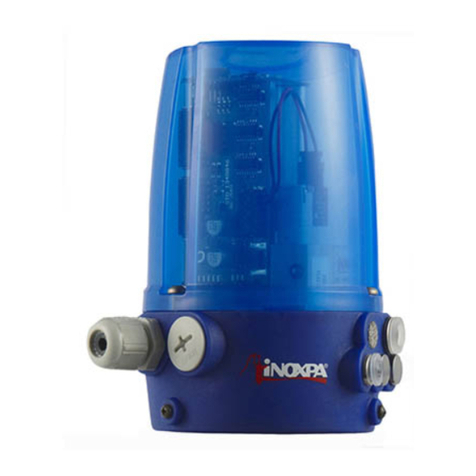
INOXPA
INOXPA C-TOP+ User manual
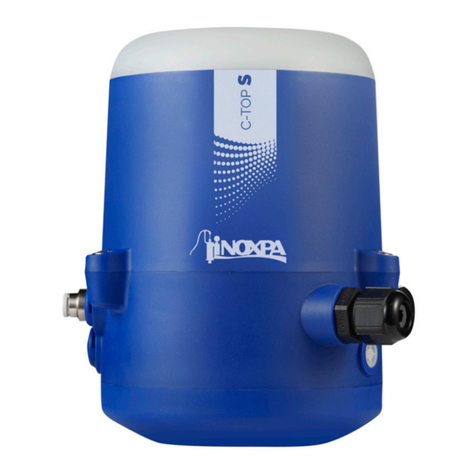
INOXPA
INOXPA C-TOP S Manual
